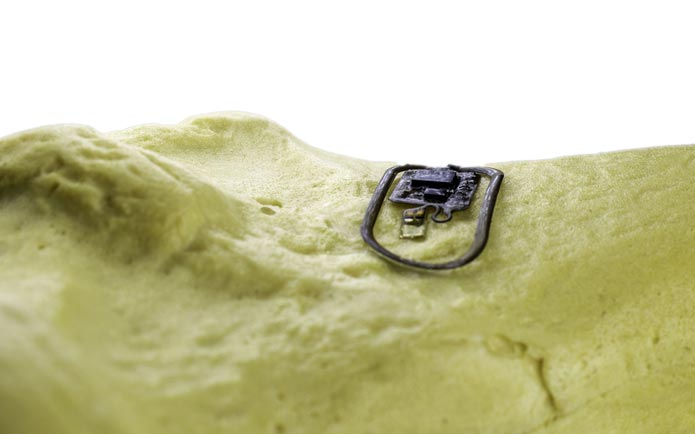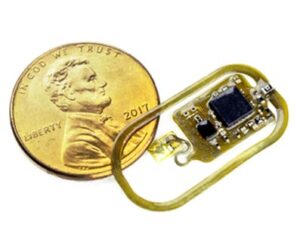Researchers develop ultra-thin ‘computer on the bone’

Osseosurface electronic devices, which attach directly to the bone, could one day help physicians monitor bone health. One is show here applied to a synthetic bone in the Gutruf Lab at the University of Arizona.
Credit: Gutruf Lab
Engineers and physicians teamed up to develop a wireless device to monitor and protect bone health.
A team of University of Arizona researchers has developed an ultra-thin wireless device that grows to the surface of bone and could someday help physicians monitor bone health and healing over long periods. The devices, called osseosurface electronics, are described in a paper published Thursday in Nature Communications.
“As a surgeon, I am most excited about using measurements collected with osseosurface electronics to someday provide my patients with individualized orthopedic care – with the goal of accelerating rehabilitation and maximizing function after traumatic injuries,” said study co-senior author Dr. David Margolis, an assistant professor of orthopedic surgery in the UArizona College of Medicine – Tucson and orthopedic surgeon at Banner – University Medical Center Tucson.
Fragility fractures associated with conditions like osteoporosis account for more days spent in the hospital than heart attacks, breast cancer or prostate cancer. Although not yet tested or approved for use in humans, the wireless bone devices could one day be used not only to monitor health, but to improve it, said study co-senior author Philipp Gutruf, an assistant professor of biomedical engineering and Craig M. Berge faculty fellow in the College of Engineering.

Credit: Gutruf Lab
“Being able to monitor the health of the musculoskeletal system is super important,” said Gutruf, who is also a member of the university’s BIO5 Institute. “With this interface, you basically have a computer on the bone. This technology platform allows us to create investigative tools for scientists to discover how the musculoskeletal system works and to use the information gathered to benefit recovery and therapy.”
Because muscles are so close to bones and move so frequently, it is important that the device be thin enough to avoid irritating surrounding tissue or becoming dislodged, Gutruf explained.
“The device’s thin structure, roughly as thick as a sheet of paper, means it can conform to the curvature of the bone, forming a tight interface,” said Alex Burton, a doctoral student in biomedical engineering and co-first author of the study. “They also do not need a battery. This is possible using a power casting and communication method called near-field communication, or NFC, which is also used in smartphones for contactless pay.”
Ceramic Adhesive Grows to Bone
The outer layers of bones shed and renew just like the outer layers of skin. So, if a traditional adhesive was used to attach something to the bone, it would fall off after just a few months. To address this challenge, study co-author and BIO5 Institute member John Szivek – a professor of orthopedic surgery and biomedical engineering – developed an adhesive that contains calcium particles with an atomic structure similar to bone cells, which is used as to secure osseosurface electronics to the bone.
“The bone basically thinks the device is part of it, and grows to the sensor itself,” Gutruf said. “This allows it to form a permanent bond to the bone and take measurements over long periods of time.”
For instance, a doctor could attach the device to a broken or fractured bone to monitor the healing process. This could be particularly helpful in patients with conditions such as osteoporosis, since they frequently suffer refractures. Knowing how quickly and how well the bone is healing could also inform clinical treatment decisions, such as when to remove temporary hardware like plates, rods or screws.
Some patients are prescribed drugs designed to speed up bone healing or improve bone density, but these prescriptions can have side effects. Close bone monitoring would allow physicians to make more informed decisions about drug dosage levels.
Journal: Nature Communications
Article Title: Osseosurface electronics—thin, wireless, batteryfree and multimodal musculoskeletal biointerfaces
Article Publication Date: 18-Nov-2021
Media Contact
Emily Dieckman
University of Arizona College of Engineering
edieckman@email.arizona.edu
Office: 760-981-8808
All latest news from the category: Medical Engineering
The development of medical equipment, products and technical procedures is characterized by high research and development costs in a variety of fields related to the study of human medicine.
innovations-report provides informative and stimulating reports and articles on topics ranging from imaging processes, cell and tissue techniques, optical techniques, implants, orthopedic aids, clinical and medical office equipment, dialysis systems and x-ray/radiation monitoring devices to endoscopy, ultrasound, surgical techniques, and dental materials.
Newest articles

Making diamonds at ambient pressure
Scientists develop novel liquid metal alloy system to synthesize diamond under moderate conditions. Did you know that 99% of synthetic diamonds are currently produced using high-pressure and high-temperature (HPHT) methods?[2]…

Eruption of mega-magnetic star lights up nearby galaxy
Thanks to ESA satellites, an international team including UNIGE researchers has detected a giant eruption coming from a magnetar, an extremely magnetic neutron star. While ESA’s satellite INTEGRAL was observing…

Solving the riddle of the sphingolipids in coronary artery disease
Weill Cornell Medicine investigators have uncovered a way to unleash in blood vessels the protective effects of a type of fat-related molecule known as a sphingolipid, suggesting a promising new…





















